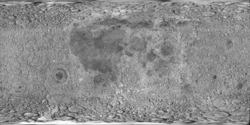Titov (kráter)
| Kráter Titov | |
|---|---|
| Souřadnice na Měsíci | |
| Selenografická šířka | 28,6° S |
| Selenografická délka | 150,3° V |
| Další údaje | |
| Průměr kráteru | 30 km |
| Hloubka | ? |
| Colongitudo | 210° |
| Eponym | German Titov |


Titov je relativně malý měsíční impaktní kráter nacházející se na severní hemisféře na odvrácené straně Měsíce, není tedy pozorovatelný přímo ze Země. Má průměr 30 km, pojmenován je podle ruského kosmonauta Germana Titova, jediného člena mise Vostok 2.[1] Je celý situován v Mare Moscoviense (Moskevském moři), jeho satelitní kráter Titov E leží naopak vně moře při jeho východním okraji. Jiho-jihovýchodně od Titova (rovněž na okraji Mare Moscoviense) lze nalézt kráter Komarov, jehož dno je zvrásněno brázdami.
Satelitní krátery
V okolí kráteru se nachází několik dalších kráterů. Ty byly označeny podle zavedených zvyklostí jménem hlavního kráteru a velkým písmenem abecedy.[1]
| Titov | Sel. šířka | Sel. délka | Průměr |
|---|---|---|---|
| E | 29,1° S | 153,9° V | 22 km |
Odkazy
Reference
Literatura
- RÜKL, Antonín. Atlas Měsíce. Praha: Aventinum, 1991. ISBN 80-85277-10-7.
Externí odkazy
 Obrázky, zvuky či videa k tématu Titov na Wikimedia Commons
Obrázky, zvuky či videa k tématu Titov na Wikimedia Commons - LAC 49, mapa 1:1 000 000 (Lambertova projekce)
Média použitá na této stránce
cylindrical map projection of the Moon. The Moon's whole surface was mapped by the Clementine spacecraft in 1994, here North is at the top. The dark floor of crater Plato is at the middle top above Mare Imbrium, while the bright floor and rays of crater Tycho is near the middle bottom below Mare Imbrium. Mare Procellarum is at the near left, and Mare Tranquillitatis is just right of centre and Mare Crisium is at the near right. The far left and far right show the contrast of the mostly cratered farside with small isolated mare.
NASA lunar chart of equatorial region (latitudes 45S to 45N) 1 : 10.000.000 (LPC-1).
en:Mare Moscoviense sits in the Moscoviense basin.Like Mare Marginis, this mare appears to be fairly thin. However, it is clearly centered within a large impact basin. It is also much lower than either the outer basin floor or the farside highlands. The great depth of this mare beneath the nearby highlands probably explains why mare units are so rare on the lunar farside. Very few basins on the farside were deep enough to allow mare volcanism. Thus, while large impact basins are found on both the nearside and farside, large mare are mostly found on the nearside. Mare lavas apparently could reach the surface more often and more easily there. The basin material is of the Nectarian epoch, while the mare material is of the Upper Imbrian epoch. The crater Komarov is seen to the southeast of the mare. You can just make out the crater Titov in the northern regin of the mare.



